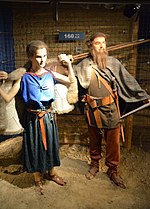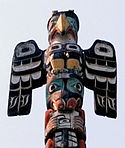Jyder (germansk folkeslag)
 Jyder er også en betegnelse for nutidens indbyggerne i Jylland.
Jyder er også en betegnelse for nutidens indbyggerne i Jylland. Denne artikel bør gennemlæses af en person med fagkendskab for at sikre den faglige korrekthed.
Denne artikel bør gennemlæses af en person med fagkendskab for at sikre den faglige korrekthed.

Jyder var et germansk folkeslag i Jylland.[1][2]
Historie
Ligesom der findes forskellige måder at afgrænse landskabet Jylland på, findes også forskellige definitioner af folkenavnet jyde. Jyderne beboede Jylland ned til Ejderen, Trenen og Egernførde Fjord[kilde mangler]. Men efter dannelsen af Hertugdømmet Slesvig har ordet ikke altid indbefattet befolkningen syd for Kongeåen (slesvigerne eller sønderjyderne). Men den sønderjyske dialekt har dog mere til fælles med de nørrejyske dialekter end med dialekterne på øerne.[kilde mangler]
Jyderne som medgrundlæggere af den angelsaksiske civilisation
Da jorden på den jyske halvø og syd herfor omkring år 500 var udpint og hederne bredte sig, og landet derfor ikke længere kunne brødføde så mange, udvandrede jyder sammen med anglere og saksere til Britannien, hvor de lagde grunden til den angelsaksiske civilisation.[1]
Kilder og henvisninger
- ^ a b Who Were the Jutes? The Mysterious Tribe Who Settled In Britain Aleksa Vuckovic 21. september 2021 på ancient-origins.net
- ^ Meyers Neues Lexikon (Mannheim 1979) und Meyers Enzyklopädisches Lexikon (Mannheim 1975) beschreiben die Jüten allgemeiner als germanischen Stamm in Jütland. web.archive.org/ 06-02-2008 hentet 23. januar 2022
 Der er for få eller ingen kildehenvisninger i denne artikel, hvilket er et problem. Du kan hjælpe ved at angive troværdige kilder til de påstande, som fremføres i artiklen.
Der er for få eller ingen kildehenvisninger i denne artikel, hvilket er et problem. Du kan hjælpe ved at angive troværdige kilder til de påstande, som fremføres i artiklen.
| Spire |
Medier brugt på denne side
Forfatter/Opretter: Silar, Licens: CC BY-SA 3.0
Man and women of fine, slender build, long narrow heads and fine features. The women wears a blue line shirts without sleeves, red-trimmed at neck and shoulder edges and fastened together in front with bronze pin and on the shoulders with silver-inlaid iron pins. Long green checered skirt , tied at the wast with a leather thong. Leather belt with the iron buckle, a knife hanging from it in a leather sheath , along with a clay whorm and iron key; spindle with a decorated clay whorl stuck in the belt. Melon-sheped bead of green grass hung around the neck. Sheep's fleece over the shoulders. Hair in thin braids arranged in a bun. Openwork leather shoes tied with thong aboves the ankle. The man's dress consists of a brown woolen shirt, long trousers of fulled wool gathered at the waist into a belt with beltv carries and kept in place with string. Short fringed cape over the shoulders, fastened with a silver brooch on of the shoulder blades. Shirt with wide leather belt fitted with an iron openwork buckle and bronze rivets, also an iron ferrule with ring. Hung at the waist : archer scissors of iron, knife in leather sheath , mounted on a leather belt colled a balteus with bronze-coverd iron tip. Harpoon and iron-headed spear in the hand, a wooden shield with iron umbo and handle in the left.Hair pulled up in a 'Swebian knot'. [Prehistory and early middle ages of Lesser Poland, Guide, Archaeological Museum in Cracow, 2006, ISBN 978-83-911543-7-3 p. 33, January 2024
Forfatter/Opretter: Dr Haggis, Licens: CC BY-SA 3.0
Thunderbird on top of Totem Pole in Thunderbird Park in Victoria, BC Canada. Taken by Dr Haggis on 29JUL04
(c) I, Casper, CC BY-SA 3.0
Jutland and the Jutland Peninsula
Red: Commonly defined as Jutland today, including the area north of the Limfjord and minor islands
Pink: The islands of Læsø, Anholt, Samsø and Als are usually attributed to Jutland as well
Brown: South Slesvig/Schleswig in the German state of Schleswig-Holstein, historically a part of Jutland
Yellow: Holstein, situated on the Jutland Peninsula, but not in Jutland itself.
The river Kongeå is the historical border between Northern and Southern Jutland (Slesvig). The river Eider is the historical southern border of Jutland (and formerly Denmark), and between Slesvig and Holstein. The city of Rendsburg and the island of Helgoland are sometimes regarded as Slesvig, sometimes not. The Jutland Peninsula as a geographic term has no fixed southern border, but at its furthest it would stretch to the river Elbe. Hamburg, however, is not a part of Holstein, and Lübeck was not a part of Holstein until the 20th century. The Jutland Peninsula may also be called the Cimbrian Peninsula, Jutland-Holstein or Jutland-Schleswig-Holstein.
Forfatter/Opretter: de:User:Schreiber, Licens: CC BY-SA 3.0
image from the German wikipedia article on en:Scandza
- Image on the German Wikipedia listed it as a GDFL




